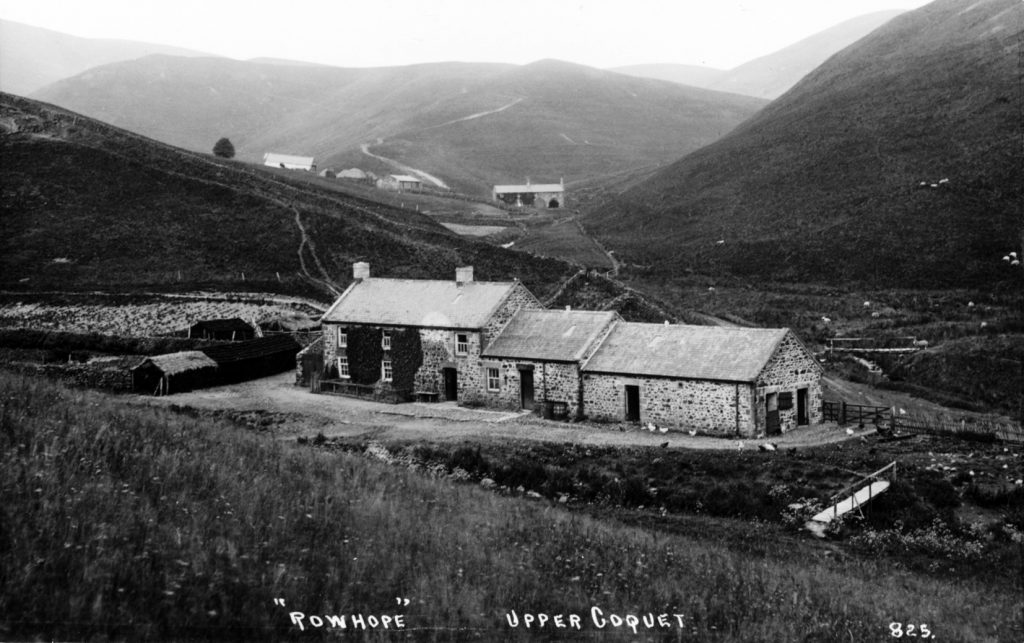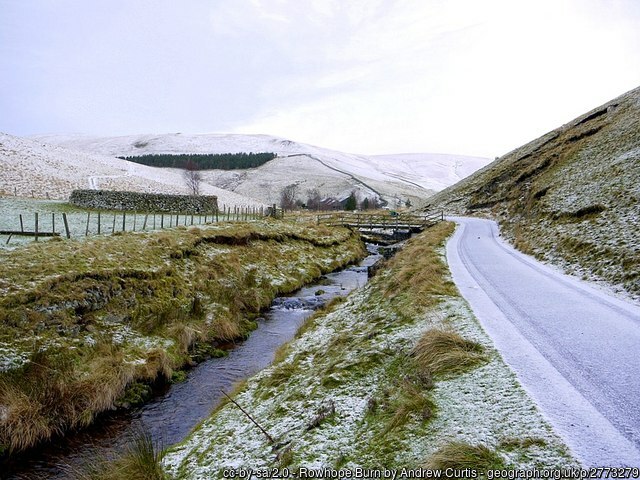Memories of Rowhope – Hannah Hutton
Submitted by: Sally Brewis - 10th November 2021
Memories of living at Rowhope for seventeen years were often of long hard winters, but as years pass I think much more of how close our living there was with nature.

The joy after cold winters when the pied wagtail would suddenly arrive on the grass outside our window and sing his heart out, tripping back and forth as if to burst with happiness. Each year we came to expect him as the signal of Spring, and he became affectionately referred to as “Wor yin” and was fed with crumbs from the table-cloth each morning.
Swallows nested each summer in both pig-sty and byre, and what a sin it was if someone closed a door at night shutting out the mother bird. I remember a chap climbing up to the nest, one year, and putting a ring on the nesting swallow – part of an official survey. On his return the following year the same bird was nesting, after travelling thousands of miles.
One morning we went up the field to see a snipe’s nest and although my husband had been certain he could go straight back to the nest, we had to search, walking west, carefully and quietly. I almost stood on her, so well did her plumage blend with the dry bent where she nested, a motionless, squat mound with only the sharp bright eye to give her away. We gently retreated.
Living on the side of the burn, in early summer we saw the wild duck with her young ones and I remember the fright I got one quiet morning when looking out of the window, I saw what I thought was a fat snake slithering into the long grass at the side of the ford. Joe realised it was mother duck leading her family of seven very young up the burn, beak-to-tail. Her head was bent in a cowering fashion in a hurry to disappear into safety with her brood. Many times we would try to find where the ducks went when we saw young ones on the stream. A thorough search under the bank-sides never revealed their hideaway.
One beautiful mallard drake was a much bolder chap. Joe was playing his pipes in the sitting room and I was clearing the supper table and it was a very quiet, still evening. Suddenly, the plump drake, his gorgeous colouring like rich satin, appeared on the track in the field over the burn, head on one side, listening! Slowly he came closer to the house, every few steps pausing to listen – his head titing from side to side. Doreen and I watched entranced and I felt at any second he would lift his feet and start dancing.
One friend in early May was the sand-piper who would skim up and down above the water with his shrill peep-peep-peep. Many times, while washing up after breakfast, I listened to his morning song, with the door wide, to enjoy his call.
The dipper was our friend on the burn who heralded autumn and winter. To us he was known as the “parson” his front was so white and spotless. On the coldest of mornings when all was frost and icicles, and nose and lips stung with the frost, he would be dipping right into the stream on the ford in front of the house, disappear, and emerge to sit bob-bobbing on an ice-covered stone while we shivered.
We have sat by the fire at night, when all was dark, and heard salmon and sea-trout fighting their way over the stones in the ford, where the water is wide and shallow, making their way upstream to spawn. The very sound of the water can indicate winter is over. The beginning of winter 1963, a very severe and long winter, I was outside cleaning windows and it was a calm and mild evening. Suddenly I noticed a different sound, one I have never heard since and we were to live at Rowhope for 12 more years. The water was chuckling and chattering as it flowed. I asked Joe to listen, and tell me if he could hear a different sound, and his reply immediately was “Yes, The burn!”. And we knew, although the snow lay thick in the gullets and on the tops, that dreadful storm, when we were cut off for twelve weeks, lay behind us. We were free! I asked one old shepherd about this and did he believe us? He said “Definitely. When you hear the burn “sing” there will be no more hard weather”.

Not all our wild visitors to Rowhope were welcome . One Autumn, “Kitty” our old cat, would fight and resist being put outside, and came the night when we heard a terrible scuffle and her wails. Joe ran with flashlight and found her at the edge of the ford, unable to get up all the mud and dirt. We nursed her round but after that she was put in the stable at night. (No horse in).
Sparky by then met with the same fate and twice developed poison from a bite and had to be taken to the vet. One morning the children and I saw this beautiful head of a ginger cat appear above the wall opposite the scullery window. We made enquiries, had any-one in the valley lost a cat as it looked as if it had become wild to be so vicious on ours. No-one had lost a cat. By now Joe knew it was sleeping in our barn by day and we were warned not to go in as it spat and hisses. Also the hay which the cows had to eat was getting a foul smell of cat.
Joe decided he had had enough. Having no gun he set a trap (which he hated doing) and waited by a window to hear him caught and dashed out and killed him – which I shall not go into. Joe hated doing this as it was against all our feelings to hurt an animal but by now we were desperate. Next morning he brought the offender around to bury and the relief we shared when we saw it was a wild cat. Tiny prick ears and a tail with dark rings, true markings of a natural wild cat and much bigger and stronger than a domestic cat. They live in forestry, we were told, and obviously he was going to take up his abode in our barn for the winter. No way.
One bird who created as much interest, one spring, in the Upper Coquet was a mistle thrush who built her nest on top of a gatepost on the roadside at the burn foot. Geoff Foreman, who ran the school car, took photos of the nest. Nothing disturbed her, and her in such a conspicuous place.
Two visitors I cannot finish without mentioning are the lark, and curlew – the sign of the National Park. To stand and listen to the sweetness of a lark’s song on a spring morning is indeed joy. The curlew, with her bubbling cry on her way home to the nest on a quiet evening, is a sound we never hear enough of.
First published in Clippings in 1989 (reprinted 1990), published by Upper Coquetdale Publications ISBN 0 9515 380 0 4



